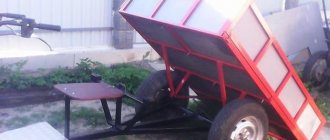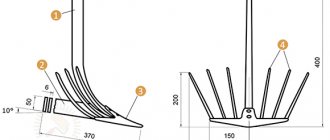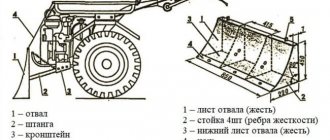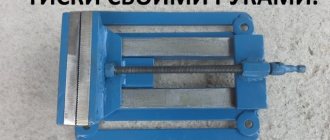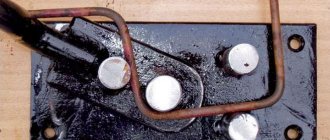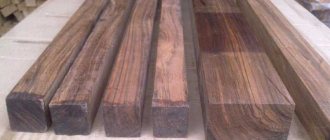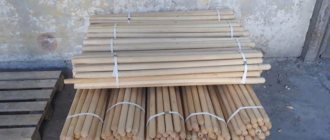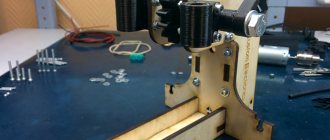A trolley for a walk-behind tractor is a towed equipment for universal agricultural motor vehicles for transporting goods on personal plots and land plots. With the help of such a mechanism, garbage, animal feed, building materials, fertilizer, grain, and equipment are transported.
The trailer and adapter for the walk-behind tractor are types of homemade products made by skilled mechanics. The adapter is a longitudinal beam with its own chassis, driver's seat and footrest. This module makes it possible to cultivate the soil in a sitting position, as well as attach 2 equipment at once - in front and behind.
A trolley is a type of adapter with a difference in the design of the chassis.
A purchased cart for a walk-behind tractor is expensive. To save money, craftsmen make it themselves, design design drawings, and select the necessary materials. The process of creating such a useful vehicle does not take much time and is not difficult. Even a beginner with at least a little knowledge of technology can handle it.
A brief overview will help you understand the question of how to make a trolley for a walk-behind tractor yourself with good performance characteristics.
Basic information
Before carrying out work on the manufacture of a trailer, it is necessary to develop a detailed action plan and adhere to it.
The work plan for the manufacture of a trailer for a walk-behind tractor looks like this:
- At the preparatory stage, it is necessary to familiarize yourself with the structure of the mechanism and analyze its functionality depending on the power of the walk-behind tractor.
- Make a design sketch. A trailer diagram drawn up yourself will greatly simplify the work.
- Calculate the dimensions of the cart for the walk-behind tractor.
- Design a drawing of the trolley, which includes the main components, parameters and dimensions of the parts.
- Plan the operating principle of the main and additional mechanisms, think through ways to connect all the components and parts, and their functioning.
- Prepare a list of necessary materials and tools.
- Start the assembly and finishing process.
Depending on the ability to transport cargo, trailers are divided into 3 types:
- A simple 1-axle attachment for walk-behind tractors with a lifting capacity of up to 70 kg. Its design is simple and inexpensive.
- Universal cart with a carrying capacity of up to 110-120 kg. Often used in households.
- Carts for walk-behind tractors with a carrying capacity of over 120 kg. Such mechanisms are designed to move heavy loads, so they have a more complex design, which increases the cost of materials for the frame and cladding. The functionality of this technology is expanding.
Based on these parameters, a material is selected based on strength for the frame and finishing of the mechanism.
Structural components
The design of the unit includes several main components. Let's look at each of them.
- Frame. It is produced mainly from a corner made of steel; round and rectangular pipe pieces are used. This main part of the product must be especially durable and withstand significant loads. The trolley is operated on uneven ground, which means the frame is subject to severe stress.
- Driven. This is a blank for the wheel axle, made of a steel circle with a diameter of 3 centimeters. The length of the axle is about 100 mm, and it is attached by corner supports by welding to the side members and the hinge body.
- The body of the unit is made of boards 2 cm wide, additionally fastened with steel corners. Next, they are strengthened on the frame using strong beams made of wooden blocks with sides of 5 cm.
- The wheels for the trolley can be used from the walk-behind tractor itself, and it is better to use them immediately together with the hub, so as not to disassemble them. The axle is sharpened on both sides until the diameter of the bearings matches. Before installation, you need to start mounting the hub. The main method for this action is pressing. The back side of the hub is bored and put on the axle. The main thing is to prevent distortion. Next, you need to install the wheel rims on the pin and tighten the nuts tightly and put on the caps.
You can make a cart for a walk-behind tractor with your own hands
- The console is used to couple the walk-behind tractor with the trolley. At the top it is secured with brackets with attachments, and at the bottom with the help of bearings the swivel unit is secured. All connections must be well lubricated and covered with special boots to prevent dirt and moisture from damaging the equipment. If the product is used very often and with heavy loads, the console is made using hinges. A drawbar is inserted into the longitudinal hinge and secured using a thrust ring. With this method, the wheels of the walk-behind tractor and the cart form a so-called independent suspension, and the unit will become much easier to control when moving on uneven ground.
- With the help of a rotating unit, the driver has the opportunity to sit on a wooden chair between the body and the motorcycle. He holds the control levers with his hands, and his feet are placed on a footrest made of corners and designed for convenience and allowing his limbs not to get tired during long-term work.
Trolley device
Motoblocks and motor-cultivators on trailers consist of the following basic elements:
- frame;
- body;
- hitch or drawbar;
- driver's seat;
- steering gear;
- chassis.
To withstand heavy loads, a homemade cart for a walk-behind tractor is reinforced with special stiffeners.
For a 1-axle trailer, a manual type device is sufficient. A 2-axle dump truck with a large load capacity must be equipped with a hydraulic drive to prevent it from tipping over.
With a load capacity of over 350 kg, for safety, the self-propelled cart is equipped with braking parts. You can make mechanical brakes yourself. If these details are not taken into account, then if overloaded while descending from a hill, the walk-behind tractor trolley will not be able to stop with its own hands and will tip over. To ensure that it remains in the working position after being disconnected from the walk-behind tractor, stops are installed.
Preliminary drawings
It is best to develop drawings yourself, according to the model of your walk-behind tractor and the available materials. To do this, you do not need to have any special education, a rough sketch will be enough. Below is a typical design of a single-axle trailer using which you can easily make a trailer for a walk-behind tractor with your own hands.
Trailer drawing. View from below.
Drawing elements:
- 1 – welded frame (angle 40x40 mm);
- 2 – thrust bearing (strip 150x40 mm, 10 mm);
- 3 – bracket (strip 100x40 mm, 10 mm);
- 4 – axle shaft (steel 45);
- 5 – wheel;
- 6 – drawbar (seamless pipe, cold-rolled, Ø 45x4 mm, L = 1.2 m);
- 7 – cardan head;
- 8 – coupling pin;
- 9 – welded poly (pieces of steel angle);
- 10 – rotary axis of the drawbar (hot-rolled round steel Ø 36 mm or a piece of steel pipe Ø 36×6 mm);
- 11 – nut (M36);
- 12 – washer;
- 13 – welded cross member (a piece of steel angle 40×40 mm);
- 14 – spacer axis (hot-rolled round steel Ø 40 mm);
- 15 – scarf (10 mm, Art. Z);
- 16 – nut (M20);
- 17 – Grover washer;
- 18 – bolt (M20).
Drawing of the trolley coupling assembly.
Drawing elements:
- 1 – pivot bushing;
- 2 – overlay;
- 3 – swivel;
- 4 – swivel bushing;
- 5 – drawbar beam;
- 6 – drawbar.
Materials and tools
To work you need the following tools:
- grinder for cutting parts;
- welding machine;
- welding electrodes;
- jigsaw;
- screwdriver;
- a regular construction square for measuring angles.
When making a trailer structure, you will need the following materials and parts:
- metal profile pipes of square or rectangular section;
- wheels and springs;
- duralumin sheets 2 mm thick;
- steel sheets;
- channel No. 5;
- metal corners;
- metal rod;
- fasteners.
All parts, especially if they are remnants of old metal products, are carefully inspected for damage, cracks, cleaned of rust, and trimmed.
Making a trolley
In order to understand how to make a cart for a walk-behind tractor with your own hands, you need to perform the following algorithm of operations:
- To make a load-bearing welded rigid frame, take 5 pipe blanks and trim the ends with a grinder.
- Press the chipboard sheet with clamps and weld the junction of 3 longitudinal pieces with 2 perpendicular ones so that they create a lattice frame.
- Check the geometry of the structure using a regular construction square. The angles of the connected ribs must be 90°.
- Install spacers between the tacked workpieces in the corners of the bottom and in the center, and tack them by welding.
- Use a welding electrode to tack 4 vertical posts in the corners to the longitudinal pipes of the bottom.
- Check the perpendicularity of the corners, check the dimensions of the sides of the structure with the dimensions on the drawing of the cart for the walk-behind tractor.
- Finally weld all the workpieces to each other, grind the welding seams, clean them of sagging and formations.
- The body can be made of plywood or wooden boards, and the corner joints are secured with steel corners.
- The boards are installed on the frame and attached using bolted connections.
- The craftsman makes stronger sides from steel sheets. The sides can be folding or fixed. Folding sides of the body are considered more rational, because Unloading large volumes of cargo is easier. The sides are also made from metal pipes of square or rectangular cross-section. They are made in the same way as the frame, they are tacked, the geometry is checked for strength and to avoid braces and deviations, they are finally welded, and rigidly attached to the frame. The tailgate is secured with ordinary door hinges and equipped with latches.
- Take a metal rod with a diameter of 30 mm and a length of about 1050 mm to make an axle for the wheels, connect it to the longitudinal hinge and corner supports. The length should be chosen so that the axle does not extend beyond the wheels. Sharpen it to the required diameters of the bearings in the hubs.
- As a running gear, you can take the wheelbase from a scooter, stroller, wheelbarrow or other agricultural machinery. Heavy wheels from a car trailer with hubs are not recommended for installation.
- To make the drawbar, take 2 profile pipes with a diameter of 25x50 mm and a length of about 1.85 m, weld them to the frame beam so that a triangular structure is obtained. For reinforcement, metal gussets 4 mm thick are attached by welding at the corners, and a plate 8 mm thick is attached to the front of the trolley.
- Tipper technology involves the installation of door hinges attached to the bottom of the beam and to the bottom struts.
- The frame of the constructed structure is covered with wooden boards, plastic or metal.
- The driver's seat is installed on a walk-behind tractor with a trolley ready-made or in the form of homemade boxes made from a piece of chipboard and foam rubber covered with dermantine. Such boxes are necessary for covering equipment and materials.
- The parking brake drive of the unit can be used as a brake. Fix the brake pedal, made of a 6 mm thick plate, on the footrest under the seat, weld 2 corners. Install a pedal in the front part, and a plate with 2 holes for fastening brake cables in the rear part, the ends of which are connected to a T-shaped plate with a rod.
In this way, you can make a trolley for a walk-behind tractor with your own hands.
Attaching the trailer to the walk-behind tractor
The trailer drawbar, like the frame, is made of 60×60 or 60×30 mm pipes. This is a double beam design with a connection in the coupling device. The coupling device is installed at the point where the drawbar beams meet. The rear ends of the pipes are welded with overlap and reinforcement to the trailer side members.
The coupling of the trailer with the hitch of the walk-behind tractor should ensure ease of rotation of the propulsion unit when moving and at the same time reliable connection with the trailer.
In a simple version, an earring made of a metal rod or reinforcement with a diameter of at least 20 mm can be used as a hitch to a standard trailer hitch. As an option, a standard car trailer hitch and tow bar are used.
For reliable articulation and ease of control of the walk-behind tractor, a pipe with a diameter of 40 mm and a length of 100 mm is welded at the junction of the drawbar beams. The axle of the towing device is installed inside the pipe on two bearings. On the trailer side, the pipe is plugged with a washer to fix the towbar axle; the diameter of the washer hole corresponds to the diameter of the towbar axle.
The axle of the trailer hitch, on one side, has a thread for fixing with a nut and a stud, and on the other, a welded hitch for connection to the walk-behind tractor.
The hitch at the end of the axle facing the walk-behind tractor is made of a square pipe 60x60 mm, 80 mm long. A through hole in the pipe, drilled through two opposite sides, must correspond to the diameter of the locking pin of the walk-behind tractor hitch and fit securely inside the towbar. Inside, the square pipe is reinforced with additional metal plates. The edges of the pipe are rounded so as not to create additional difficulties when turning.
On the trailer side, the towbar axle is secured with a nut and a locking pin.
As a result, when connecting the trailer hitch into the hitch eye of the walk-behind tractor and fixing the hitch with a finger, the walk-behind tractor and the trailer must be securely connected, ensuring stability and ease of control when moving.
Do-it-yourself trolley for a motorized towing vehicle
A motorized towing vehicle (motorized dog) is a device for transporting goods and traveling through snow and wetlands. The towing vehicle itself has a caterpillar track and is complemented by a sleigh. A trailer in the form of a sleigh is convenient in winter, provided there is a large snow cover, but in summer or in snowless winters, using such a trailer is problematic.
Manufacturers of agricultural equipment offer a wide selection of trailers, adapters and carts, including those for motorized towing vehicles. Some owners of such equipment create a cart with their own hands. Its device is practically no different from a trolley for a walk-behind tractor.
The main difference between a motorized towing vehicle, which dictates the design features of trailers, is the caterpillar track. Such vehicles are ideal for off-road use, so the trailer must meet the same requirements.
Two types of trailers are recommended for motorized dogs: a cargo platform and a skidder. Both options are difficult to implement, so it is better to adapt a ready-made trolley for a walk-behind tractor. The drawings and dimensions for the motorized towing vehicle and the walk-behind tractor will be almost the same, so you can use any.
The main feature of a trailer for this type of equipment is low-pressure wheels. They have a high shock-absorbing effect and are excellent for off-road use. A cart with such wheels can be used at any time of the year. This modification requires the trolley to strengthen the axle, as well as fasten the wheels. All other parts of the cart may remain unchanged.
DIY wheelbarrow for walk-behind tractor
A wheelbarrow for a walk-behind tractor is an indispensable assistant in the household. This device allows you to transport cargo (harvest, garbage, building materials, etc.). You can make a cart for a walk-behind tractor with your own hands from auto parts or from individual materials. In both cases, welding and certain design skills will be required. The wheelbarrow assumes the simplest design; any drawing of a trailer for walk-behind tractors will do to create it.
For the Neva MB-2 walk-behind tractor, a mounted wheelbarrow with an H-shaped hitch is suitable. This type of connection is universal and easy to make. The coupling point between the wheelbarrow and the walk-behind tractor is one of the most important components that receives a large load, so the materials for its creation must be durable, and checking for defects (cracks, rust) is mandatory.
A wheelbarrow for a walk-behind tractor consists of a frame, sides and wheels. If you add a seat and a steering column to it, you get an analogue of a mini-tractor. Any of the wheelbarrow options for a walk-behind tractor can be made from available materials; there are many photos and videos on the Internet with the process of assembling devices.
Do you use trailers, adapters and wheelbarrows for walk-behind tractors?
Types and purpose of models of main structures of walk-behind trailers
The main types and models of trailers for self-made walk-behind tractors are classified according to the type of homemade body part design:
- one-piece structures;
- transformable structures with folding sides;
- tipper body types.
The one-piece design of the trailer includes a rigid, non-removable side body. Due to the rigidity of the design, the trailer allows you to transport cargo both in bulk and in packaged form. The body has a large rigid frame platform connected by a welded joint to the side guards. A folding tailgate is provided for loading and unloading.
Transformer structures are trailers for universal use; they have the functions of both a rigid body trailer and a platform for transporting large cargo. The frame base is a rigid base, and folding or removable sides during transformation form an additional area of the flat platform.
The tipper type of walk-behind trailers allows for tipping and unloading of bulk cargo without additional effort.


